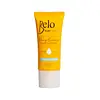What's inside
What's inside
 Key Ingredients
Key Ingredients

 Benefits
Benefits

 Concerns
Concerns

 Ingredients Side-by-side
Ingredients Side-by-side

Water
Skin ConditioningEthylhexyl Methoxycinnamate
UV AbsorberCyclotetrasiloxane
EmollientCyclopentasiloxane
EmollientCetyl Alcohol
EmollientGlyceryl Stearate
EmollientCeteareth-20
CleansingCeteareth-12
EmulsifyingCetearyl Alcohol
EmollientCetyl Palmitate
EmollientButyl Methoxydibenzoylmethane
UV AbsorberOctocrylene
UV AbsorberBenzyl Alcohol
PerfumingGlyceryl Caprylate
EmollientGlyceryl Undecylenate
EmollientButyrospermum Parkii Butter
Skin ConditioningC12-15 Alkyl Benzoate
AntimicrobialTitanium Dioxide
Cosmetic ColorantAluminum Hydroxide
EmollientDimethicone/Methicone Copolymer
Sorbitan Palmitate
EmulsifyingSorbitan Olivate
EmulsifyingCarbomer
Emulsion StabilisingTriethanolamine
BufferingBisabolol
MaskingPanthenol
Skin ConditioningSodium Polyacrylate
AbsorbentTocopheryl Acetate
AntioxidantCitric Acid
BufferingTetrasodium EDTA
Benzylidene Dimethoxydimethylindanone
Skin ProtectingWater, Ethylhexyl Methoxycinnamate, Cyclotetrasiloxane, Cyclopentasiloxane, Cetyl Alcohol, Glyceryl Stearate, Ceteareth-20, Ceteareth-12, Cetearyl Alcohol, Cetyl Palmitate, Butyl Methoxydibenzoylmethane, Octocrylene, Benzyl Alcohol, Glyceryl Caprylate, Glyceryl Undecylenate, Butyrospermum Parkii Butter, C12-15 Alkyl Benzoate, Titanium Dioxide, Aluminum Hydroxide, Dimethicone/Methicone Copolymer, Sorbitan Palmitate, Sorbitan Olivate, Carbomer, Triethanolamine, Bisabolol, Panthenol, Sodium Polyacrylate, Tocopheryl Acetate, Citric Acid, Tetrasodium EDTA, Benzylidene Dimethoxydimethylindanone
Water
Skin ConditioningC12-15 Alkyl Benzoate
AntimicrobialTitanium Dioxide
Cosmetic ColorantPropanediol
SolventButylene Glycol
HumectantAcrylates Copolymer
Niacinamide
SmoothingCetyl Ethylhexanoate
Emollient1,2-Hexanediol
Skin ConditioningAluminum Stearate
Cosmetic ColorantPolyhydroxystearic Acid
EmulsifyingPentylene Glycol
Skin ConditioningPolymethylsilsesquioxane
Caprylic/Capric Triglyceride
MaskingPinus Pinaster Bark Extract
AntioxidantCeramide NP
Skin ConditioningOlea Europaea Fruit Oil
MaskingFicus Carica Fruit Extract
HumectantCentella Asiatica Extract
CleansingLactobacillus Ferment Lysate
Skin ConditioningSodium Hyaluronate
HumectantSilica
AbrasiveAlumina
AbrasiveGlycerin
HumectantHydrogenated Lecithin
EmulsifyingStearic Acid
CleansingHydroxypropyl Methylcellulose Stearoxy Ether
Sodium Stearoyl Glutamate
CleansingPolyacrylate Crosspolymer-6
Emulsion StabilisingTocopherol
AntioxidantAstaxanthin
Skin ConditioningHyaluronic Acid
HumectantSodium Hyaluronate Crosspolymer
HumectantHydrolyzed Hyaluronic Acid
HumectantAscorbyl Propyl Hyaluronate
Skin ConditioningHydroxypropyltrimonium Hyaluronate
Adenosine
Skin ConditioningAmmonium Acryloyldimethyltaurate/Vp Copolymer
Hydrolyzed Sodium Hyaluronate
Skin ConditioningSodium Acetylated Hyaluronate
HumectantXanthan Gum
EmulsifyingT-Butyl Alcohol
PerfumingEthylhexylglycerin
Skin ConditioningWater, C12-15 Alkyl Benzoate, Titanium Dioxide, Propanediol, Butylene Glycol, Acrylates Copolymer, Niacinamide, Cetyl Ethylhexanoate, 1,2-Hexanediol, Aluminum Stearate, Polyhydroxystearic Acid, Pentylene Glycol, Polymethylsilsesquioxane, Caprylic/Capric Triglyceride, Pinus Pinaster Bark Extract, Ceramide NP, Olea Europaea Fruit Oil, Ficus Carica Fruit Extract, Centella Asiatica Extract, Lactobacillus Ferment Lysate, Sodium Hyaluronate, Silica, Alumina, Glycerin, Hydrogenated Lecithin, Stearic Acid, Hydroxypropyl Methylcellulose Stearoxy Ether, Sodium Stearoyl Glutamate, Polyacrylate Crosspolymer-6, Tocopherol, Astaxanthin, Hyaluronic Acid, Sodium Hyaluronate Crosspolymer, Hydrolyzed Hyaluronic Acid, Ascorbyl Propyl Hyaluronate, Hydroxypropyltrimonium Hyaluronate, Adenosine, Ammonium Acryloyldimethyltaurate/Vp Copolymer, Hydrolyzed Sodium Hyaluronate, Sodium Acetylated Hyaluronate, Xanthan Gum, T-Butyl Alcohol, Ethylhexylglycerin
 Reviews
Reviews

Ingredients Explained
These ingredients are found in both products.
Ingredients higher up in an ingredient list are typically present in a larger amount.
C12-15 Alkyl Benzoate is made up of Benzoic Acid and long chain alcohols. It has a low molecular weight.
C12-15 Alkyl Benzoate is an emollient and texture enhancer. Due to its solubility, it is often used in sunscreens to help evenly distribute active ingredients.
As an emollient, C12-15 Alkyl Benzoate helps soften and hydrate your skin. Emollients create a film on your skin that traps moisture within.
This ingredient has been reported to cause eye irritation.
Learn more about C12-15 Alkyl BenzoateTitanium dioxide is a mineral UV filter widely used in sunscreens and cosmetics.
It is one of only two UV filters officially classified as “mineral” by regulatory agencies, the other being zinc oxide.
Titanium dioxide provides broad-spectrum protection mostly in the UVB and UVAII range, with some protection in the UVAI range.
While its UVA protection isn’t as strong as zinc oxide’s, the difference is minor.
A common myth is that mineral UV filters reflect UV light. However, modern research shows titanium dioxide absorbs UV radiation like chemical filters (~95% absorption & 5% reflection).
Thanks to its non-irritating nature, titanium dioxide is suitable for sensitive, acne-prone, or redness-prone skin. It is unlikely to cause "eye sting" like other sunscreen ingredients.
A major drawback of this ingredient is its white cast and thick texture. This is why mineral sunscreens often leave a white cast and are less cosmetically elegant than chemical/hybrid sunscreens.
To improve white cast and spreadability, micronized or nano-sized titanium dioxide is often used.
There are ongoing concerns surrounding nano-titanium oxide's impact on marine ecosystems.
There is no conclusive evidence that any form of titanium oxide (or any other sunscreen ingredients) will cause harm to marine ecosystems or coral reefs. The science is still developing but many consumers are keeping a close eye on this issue.
Please note, many destinations have reef-safety sunscreen rules. For instance, the U.S. Virgin Islands advises all visitors to use non-nano mineral sunscreens.
Nano mineral sunscreens once raised safety concerns about absorption into skin.
Extensive research has shown that they do not penetrate healthy or damaged skin; they remain safely on the surface and the top layer of dead skin (stratum corneum).
You'll likely find titanium dioxide bundled with alumina, silica, or dimethicone. These ingredients help make titanium dioxide highly photostable; this prevents it from interacting with other formula components under UV light.
Learn more about Titanium DioxideWater. It's the most common cosmetic ingredient of all. You'll usually see it at the top of ingredient lists, meaning that it makes up the largest part of the product.
So why is it so popular? Water most often acts as a solvent - this means that it helps dissolve other ingredients into the formulation.
You'll also recognize water as that liquid we all need to stay alive. If you see this, drink a glass of water. Stay hydrated!
Learn more about Water